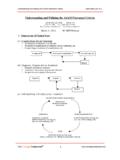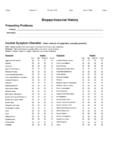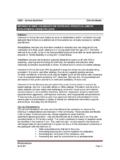Transcription of Management of upper limb disorders and the biopsychosocial ...
1 Health and Safety Executive Management of upper limb disorders and the biopsychosocial model Prepared by the University of Huddersfield, Health Services Consultancy, Humane Technology Ltd, Rolls Royce plc and Pulvertaft Hand Centre for the Health and Safety Executive 2008 RR596 Research Report Health and Safety Executive Management of upper limb disorders and the biopsychosocial model A K Burton1, N A S Kendall2, B G Pearce3 L N Birrell4, L C Bainbridge5 1 Centre for Health and Social Care Research, University of Huddersfield 2 Health Services Consultancy, London 3 Humane Technology Ltd, Rothley 4 Rolls Royce plc, Derby 5 Pulvertaft Hand Centre, Derbyshire Royal Infirmary This review, using a best evidence synthesis, examined the evidence on Management strategies for work relevant upper limb disorders and established the extent to which the biopsychosocial model can be applied.
2 Articles were found through systematic searching of electronic databases together with citation tracking. Information from included articles was extracted into evidence tables. Themes were identified and the information synthesised into high level evidence statements, which were distilled into key messages. The main results are presented in thematic sections covering classification/diagnosis, epidemiology, associations/risks, and Management /treatment, focusing on return to work and taking account of distinctions between non specific complaints and specific diagnoses. Neither medical treatment nor ergonomic workplace interventions alone offer an optimal solution; rather, multimodal interventions show considerable promise, particularly for vocational outcomes.
3 Early return to work, or work retention, is an important goal for most cases and may be facilitated, where necessary, by transitional work arrangements. The emergent evidence indicates that successful Management strategies require all the players to be onside and acting in a coordinated fashion; this requires engaging employers and workers to participate. The biopsychosocial model applies: biological considerations should not be ignored, but it is psychosocial factors that are important for vocational and disability outcomes. Implementation of interventions that address the full range of psychosocial issues will require a cultural shift in the way the relationship between upper limb complaints and work is conceived and handled.
4 A number of evidence based messages emerged, which can contribute to the needed cultural shift. This report and the work it describes were funded by the Health and Safety Executive (HSE). Its contents, including any opinions and/or conclusions expressed, are those of the authors alone and do not necessarily reflect HSE policy. HSE Books Crown copyright 2008 First published 2008 All rights reserved. No part of this publication may be reproduced, stored in a retrieval system, or transmitted in any form or by any means (electronic, mechanical, photocopying, recording or otherwise) without the prior written permission of the copyright owner.
5 Applications for reproduction should be made in writing to: Licensing Division, Her Majesty s Stationery Office, St Clements House, 2 16 Colegate, Norwich NR3 1BQ or by e mail to hmsolicensing@cabinet Acknowledgements We are grateful to the following colleagues, from a variety of disciplines, who kindly reviewed the penultimate draft and offered helpful ideas and comments: Frank Burke, David Coggon, Serena McCluskey, Margaret Hanson, Trang Nguyen, David Randolph, and Mary Wyatt. We thank Debbie McStrafick for her administrative assistance, in particular for retrieving and carefully archiving the selected articles.
6 Ii EXECUTIVE SUMMARY BACKGROUND The study started from the recognition that upper limb disorders are experienced by most people, predominantly during working age: in that sense they can be considered to be common health problems. Although there is evidence that common health problems in general are characterised by a strong association with psychosocial factors, it is uncertain to what extent that holds true for upper limb disorders in particular. The Health & Safety Executive acknowledges that not all work-relevant upper limb disorders can be prevented, and therefore has an interest in determining whether there are effective methods for managing cases, with particular focus on the suitability of a biopsychosocial approach, to help reduce the working days lost to musculoskeletal problems.
7 This review aimed to provide an evidence-base for that question. METHODS The methodology was a best evidence synthesis : summarising the available literature and drawing conclusions about the balance of evidence, based on its quality, quantity and consistency. A systematic search of major electronic databases was undertaken using appropriate keywords to retrieve articles pertaining to the development and Management of upper limb disorders . In addition citation tracking was undertaken, together with searches of personal databases and the Internet.
8 Each article for inclusion (n ~ 200) was read and summarised; the original authors main findings were extracted, checked, and entered into evidence tables. Themes were identified from the evidence tables and the information was synthesised into high level evidence statements and linked to the supporting evidence, which was graded to reflect the level of support. Finally, the retrieved material was then distilled into a number of key messages related to the aim of the project. FINDINGS The main results are presented in thematic sections covering classification/diagnosis, epidemiology, associations/risks, and Management /treatment, focusing on return to work and taking account of distinctions between non-specific complaints and specific diagnoses.
9 As well as high level evidence statements, the main evidence themes are discussed in narrative format to further develop the ideas and put them into context, with particular reference to a biopsychosocial framework. There is considerable uncertainty over classification and diagnosis for upper limb disorders ; the inconsistent terminology impacts on studies of their epidemiology, treatment, and Management . upper limb disorders are commonly experienced irrespective of work and can lead to difficulty undertaking everyday tasks; this applies to specific diagnoses as well as non-specific complaints.
10 Work has a limited overall role in the primary causation of ULDs, yet the symptoms are frequently work-relevant (some work tasks will be difficult for people experiencing upper limb symptoms, and may sometimes provoke symptoms that may otherwise not materialize). Management of cases shows more promise than attempts at primary prevention. Neither medical treatment nor ergonomic workplace interventions alone offer an optimal solution; rather, multimodal interventions show considerable promise, particularly for vocational outcomes. Some specific diagnoses may require specific biomedical treatments, but the components of supplementary interventions directed at securing sustained return to work seem to be shared with regional pain disorders .















